Rage of the Behemoth: A Review
Wednesday, August 19, 2009
posted by Deuce Richardson
 Print This Post
Print This Post
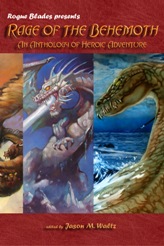
The new sword-and-sorcery anthology from Rogue Blades Entertainment, Rage of the Behemoth, has hit the streets (and my mailbox). In this newest offering from RBE, editor Jason M. Waltz has upped the ante. Overall, this collection of S&S tales exceeds its worthy predecessor in both quality and consistency. Waltz’s theme for this book is that each protagonist must face a “behemoth”; in other words, a “large monster” of some sort. Despite my initial scepticism, the idea works well.
Right off the bat, Rage of the Behemoth just looks better than its older sibling. Johnney Perkins turned in an eye-catching painting for the cover of The Return of the Sword. His work on the multiple covers for Rage of the Behemoth is another big step forward for him. Waltz has also enlisted the talents of the Frenchman, Didier Normand, for the multiple covers featured in this edition. Normand’s art is obviously influenced by Frank Frazetta (which Normand admits). However, Normand not only captures, to an extent, the look of the Michelangelo of Brooklyn, he also does a good job of capturing the feel and energy of Frazetta (in my humble opinion). At his best, Normand reminds me of the late-’70s Ken Kelly. I’ll be keeping an eye on this guy. Interior artist, John Whitman, turns in some solid line-work for the book, but I found myself wishing that the inking was a bit better.
Cimmerian alumnus, [redacted], provides the introduction for this volume. His lead-off sentence, a true keeper, is, “Mock Sword and Sorcery at your own peril.” The rest of the intro maintains that standard and tone. John O’Neill, publisher and editor of Black Gate magazine, turns in a good foreword.
Just to get it out of the way: the first two stories in this book are not really worth reading, in my opinion. The good news is that all the rest, to one extent or another, most definitely are. Let’s get to ’em…
“Black Water,” by Sean T.M. Stiennon is a tale I wasn’t sure I would like initially. The protagonist, Shabak, is a kabrisk, a member of a race of “Ancients” who ruled the seas before the advent of mankind. To put it bluntly, Shabak is a “crab man.” He is also the foster-father of a human boy. The boy, Drace, is the biological son of Valedarius, who was a mortal enemy of Shabak. The story is one involving the sins of fathers past and the sacrifices of foster-fathers present. The eponymous monster in this tale has ample reason for his vendetta; sort of a crustaceanoid Roy Batty, in his tentacular, pincered way. For me, the battle that ensues between Black Water and Shabak evoked positive comparisons with the climactic show-down in “Xuthal of the Dusk.” A well-told tale that won me over.
Robert A. Mancebo’s “Passion of the Stormlord” is a tight, well-written story. His hero, Asad al Din, is a hard-bitten sea-dog, but one also possessing wit and compassion. Asad reminded me a bit of Rabir, the Zanjian ship-captain in the “Imaro” series. I look forward to more tales of Asad al Din.
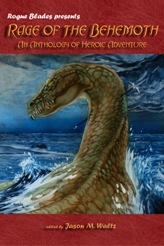 “The Beast in the Lake,” from Australian author, Kevin Lumley, is a fast-moving tale set in a vaguely “Caledonian” milieu. His take on “Nessie” is a good one, working in several facets from the Scottish legend. The protagonist, Crow Thiefmaster, is a likeable (and honorable) rogue.
“The Beast in the Lake,” from Australian author, Kevin Lumley, is a fast-moving tale set in a vaguely “Caledonian” milieu. His take on “Nessie” is a good one, working in several facets from the Scottish legend. The protagonist, Crow Thiefmaster, is a likeable (and honorable) rogue.
Englishman Carl Walmsley’s, “Serpents Beneath the Ice,” is a stand-out for several reasons. Foremost, he introduces a new type of sword-and-sorcery hero in the person of Fenn. I am a long-time fan of Glen Cook’s “Garrett” series. In the Garrett novels, Cook essentially blended the hard-boiled detective genre into a sword-and-sorcery setting. Walmsley has done something similar, only his Fenn is something of a cross between Richard Francis Burton and Samuel Butler. In other words, the Victorian travel-writer/explorer adapted to a gritty fantasy world.
Walmsley’s innovation is not the only attraction of “Serpents Beneath the Ice.” Fenn is accompanied by two fully-realized partners. These are not “side-kicks.” While both work for Fenn, neither is subservient, nor does either provide comic relief of any sort. Conner is the deadly right sword-hand of Fenn (whose primary skills lie in the thaumaturgic realms). Nomo is Fenn’s “scribe” and chronicler, the Lowell Thomas to Fenn’s Lawrence. In addition, the two “native guides” in the story are neither cardboard cutouts nor cannon-fodder, but bad-ass characters in their own right. The ending of the tale has a good twist.
Bill Ward delivers the grim and gritty goods once again in this anthology, just as he did in The Return of the Sword, with “The Wolf of Winter.” Ward’s red-handed protagonist, Krhanik Black Heart, is akin to London’s Tostig Lodbrog and Howard’s Asgrimm, only even more ruthless and writ larger. One of the best stories in this collection.
“Nothing Left of the Man,” from Jeff Stewart, sees the return of his hero, Sigurd Grimbrow. Sigurd is now captain of a long-ship. He and his crew weigh anchor in a Russianesque town haunted by a monster. There are no clear “bad guys” in this tale. Sigurd and his men just do what they have to, which is survive and then get the hell outta Kazakstan.
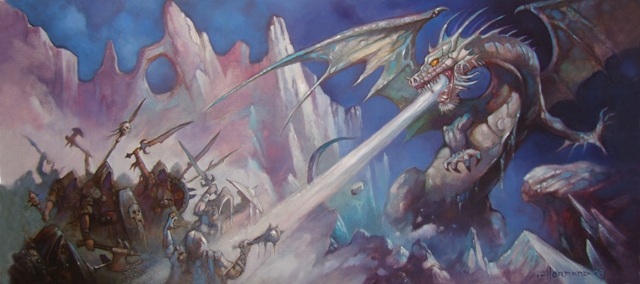
Mary Rosenblum’s “Blood Ice” is set in a frigid, snowy clime. Still, that’s no excuse for all the “ice this” and “snow thats” in this story. Edgar Rice Burroughs showed all subsequent writers of speculative fiction how to give distinctive names to outre fauna. “Ice stallion” just doesn’t cut it. Too descriptive on the one hand and not enough on the other. Gene Wolfe also had claw-footed horses in his “New Sun” novels. He called them “destriers” and left it at that. A better solution, in my opinion. Still, Rosenblum makes up for her awkward nomenclature with vigorous plotting, action and characterization.
“Black Diamond Sands” is a tale by Lois Tilton. The protagonist, Urai, in order to win his (and his sister’s) emancipation from the utterly ruthless (and just plain nasty) sorcerer, Amit, must allow himself to be enslaved by the mysterious Alamaassin. This is all in service of discovering the source of the magical gems over which the Alamaassin exercise total control. The veteran, long-suffering slave, Graybeard, is a memorable character. Urai himself is likeable and resourceful. Essentially, this story revolves around paying for the sins of one’s predecessors and taking care of one’s own, with a promise of revenge served cold (but straight from the scorching sands of the Harrara) on the final page.
Martin Turton’s “The Hunter of Rhim” begins in a vaguely post-apocalyptic setting that evokes King’s “Gunslinger” books as well as Gemmell’s “Jerusalem Man” novels. His “Sagarki” appear to be some sort of gigantic, reptilian “demons” who randomly possess humans in this Sergio Leonesque world. Like Ridley Scott’s Deckard, Turton’s Jon Hunter is a near-outcast with a past in his own troubled society. The tale has a good twist to it.
“As From His Lair, the Wild Beast” (great title) by Michael Ehart continues the adventures of Miri and her mother, Ninshi, as they seek to escape the priests (?) of Ishtar. Well-written. Imagine a female version of Wagner’s Kane (sort of), along with his daughter, Klesst, on the run from the forces of the Mesopotamian theocracy. The “behemoth”‘/beast of the tale is one that has been widely ignored in S&S fiction, despite its (once) well-known ferocity and lethality in medieval and Classical legendry. About time someone utilized it. At the same time, Ehart references the original “behemoth” of the Book of Job (thereby taking this anthology’s theme and title back to its linguistic/mythological roots), but puts a spin on it that never occurred to me.
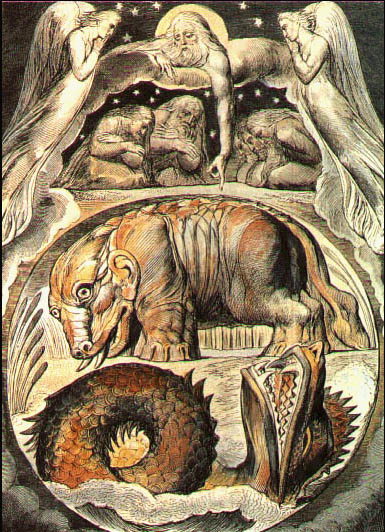
“Stalker of the Blood-Red Sands” by A. Kiwi Courters is an exciting story from a promising author. Set in a milieu recalling pre-Classical Kush, the two main protagonists are women (much like Ehart’s story). It all boils down to a classic “hunting” tale that might have appealed to Lord Dunsany as well as Charles R. Saunders.
Kate Martin spins a solid yarn featuring her heroes, Weylin and Rica, in “Poisonous Redemption.” It begins in fine Howardian fashion. That’s to say, in media res. The pair’s quarry is a basilisk (another neglected lethal critter of legend). In my opinion, this is a quality update/improvement upon the concept introduced in the film, Ladyhawke.
Bruce Durham’s “Yaggoth-Voor” is a sequel to his fine tale, “Valley of Bones,” from Return of the Sword. Both feature Mortlock the Footman, a workaday soldier who makes ends meet by making other men meat for the crows. Durham, an admirer of Robert E. Howard and Glen Cook, gives us a hero both authors would root for, in my opinion. The “Sarge” character is also carried over from “Valley of Bones” and I’m glad of it. In this story, it is revealed that Mortlock slogs and slaughters through the same world as Durham’s swashbuckling hero, Dalacroy Kildonan, though Mortlock’s era is a few centuries later. Mortlock is a “pike and shot” man. His setting is analogous to that which produced the Spanish tercio and Cromwell’s New Model Army. It might be just me, but I also sense dim echoes of Cornwell’s “Sharpe” series in the tales of Mortlock. All in all, a different story in a different setting featuring a different hero. One of the best tales in the book.
“Runner of the Hidden Ways” from Jason E. Thummel would be a stand-out story for no other reason than it finally revives the Native American sword-and-sorcery tradition (“spear-and-sorcery”?, “macuahuitl-and-sorcery”?) pioneered by Robert E. Howard himself in “The Thunder-Rider.” As Charles C. Mann notes in 1491, all the recent archaeological evidence indicates that the Americas were just as densely populated (and diverse) as Europe, Asia and Africa before Columbus hit the Antilles. The Western Hemisphere deserves its own “Nyumbani” (it contains almost thirty percent of the planet’s land surface, after all). Thummel’s story is fine without the added subtext. His mix of loss, rebellion, lycanthropy and sheer guts adds up to a rippin’ yarn.
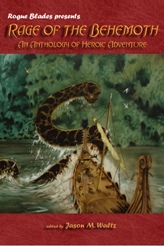 Scottish author, Brian Ruckley, keeps things rockin’ (Native) American-style with “Beyond the Reach of his Gods.” Pseudo-Vikings (led on their El Dorado-esque foray by their captain, Rhuan) in a vaguely Yucatecan setting beset by the Father of All Matatoros. Perhaps “matagalera” would be a better term for Rhuan’s adversary. Titanoboa has nothing on this living god, full of ophidian wrath.
Scottish author, Brian Ruckley, keeps things rockin’ (Native) American-style with “Beyond the Reach of his Gods.” Pseudo-Vikings (led on their El Dorado-esque foray by their captain, Rhuan) in a vaguely Yucatecan setting beset by the Father of All Matatoros. Perhaps “matagalera” would be a better term for Rhuan’s adversary. Titanoboa has nothing on this living god, full of ophidian wrath.
The relationship betwixt Rhuan and Ahenotoc (a native with a grudge against Rhuan’s foes) echoes that of Niord and Grom in “The Valley of the Worm,” as does their strategy in regards to the “behemoth” of the tale. There is also a nod to the second chapter of “Queen of the Black Coast.”
For any readers curious about the intersections of Native America and weird literature, I suggest they take a look at the website of Amy Sturgis.
C.L. Werner (a fan of Howard, Rohmer and HPL) should be no stranger to those familiar with the “Warhammer” book series. In “The Rotten Bones Rattle,” we are treated to an adventure featuring Werner’s Nipponesque hero, Shintaro Oba. Shintaro seems to be Werner’s idea of what might happen if REH’s Solomon Kane grew out of a Japanese milieu and was played by Toshiro Mifune. The ninja, Meiko, and the yamabushi, Eiji, are well-drawn characters that round out this tale. Werner also gives a shout-out to Klarkash-Ton by name-checking “Mhu-Thulan” and “Vulthoom.” It’s possible that the “behemoth” of this tale was inspired in some way by the eponymous monster in Clark Ashton Smith’s “The Colossus of Ylourgne.” If so, I can only compliment Mr. Werner on his taste and knowledge of the field, since that fine story was one of the first sword-and-sorcery tales ever spun by an author other than Robert E. Howard. At some point in the future, I will take a look at CAS’ seminal contributions to the sub-genre we all love.
Daniel R. Robichaud’s, “Vasily and the Beast Gods,” is (apparently) situated in a Eurasia long-recovered from (but still haunted by) a world-wide nuclear exchange. Vasily’s encounter with “Little Grandfather” and the contest that it precipitates was the highlight of this tale for me.
“Thunder Canyon” from Jeff Draper worked for me. The human protagonist, Rath, is sympathetic and very human. He’s just a man doing what he feels he must, even if that involves his own death. Cairrg, the non-human protagonist, is well-drawn, as is (the unfortunately named) Skurge, the nomad chieftain who comes across as a mobster in over his head. There are echoes of Tarzan the Untamed and Jeremiah Johnson in this, intended or not. I look for forward to more tales of Rath and Cairrg.
John Humble (whose surname is a bit misleading), the hero of T.W. Williams’ “Where the Shadow Falls,” is one of the most memorable protagonists in the entire anthology. Sort of a mixture of Jack Aubrey, Richard Sharpe and John Hawkwood, to my mind. I won’t give too much of the story away. I’ll just note that I’ve never, ever read a tale where a griffin was a sympathetic and crucial character… except for Richard Purtill’s novel of Homeric fantasy, The Golden Gryphon Feather.
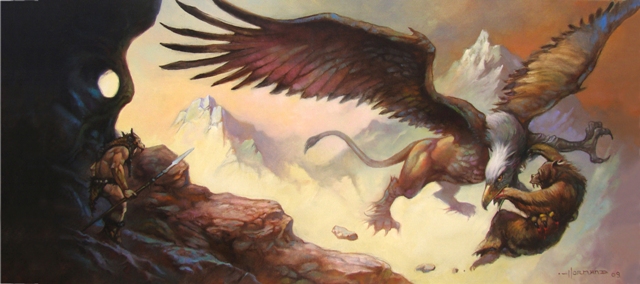
Rage of the Behemoth delivers exciting, engaging stories that exhibit astounding diversity without ever wandering into the nonsensical kingdom of political correctness. All in all, Mr. Waltz, his artists and his authors have plenty to be proud of.
*Art by Perkins, Normand and Blake.
